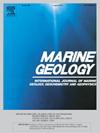重建墨西哥瓦哈卡州里约热内卢Grande海岸全新世地震和海啸历史
IF 2.2
3区 地球科学
Q2 GEOSCIENCES, MULTIDISCIPLINARY
引用次数: 0
摘要
这项研究旨在确定墨西哥瓦哈卡地区过去的地震和海啸,这是科科斯和北美板块之间的俯冲带的一部分。我们利用基于硅藻的传递函数从沉积记录中重建了古海拔,以识别与陆面变化相关的同震、震后、震间和永久变形。为了实现这一目标,我们利用现代硅藻开发了一个古海拔模型。确定了4个异域砂层为海啸沉积及其引发的地震和同震隆升沉降。单元1(1769±74 CE)记录了0.065±1.04 m的同震隆起,与1787年8.6级地震和海啸有关。第2单元(1085±40 CE)记录的同震隆升为0.082±0.93 m。单元3(830±45 CE)同震沉降为−0.091±1.08 m。第4单元的年代介于公元前811年至751年和公元前766年至465年之间,记录了同震隆起0.513±0.37米,可能是由>;7.5级海啸性地震。从地表变化推断出的重建震级揭示了一个变化的地震历史。最后,我们确定了在过去2800年中累积的永久隆起变形为0.76 m。本文章由计算机程序翻译,如有差异,请以英文原文为准。

Reconstructing Holocene seismic and tsunami history along the Rio Grande coast, Oaxaca, Mexico
This study aims to identify past earthquakes and tsunamis in the Oaxaca region of Mexico, a segment of the subduction zone between the Cocos and North American plates. We reconstructed paleoelevations from the sedimentary record using diatom-based transfer functions to identify co-seismic, post-seismic, inter-seismic, and permanent deformation associated with land-level changes. To achieve this, we developed a paleoelevation model using modern diatoms. Up to four allochthonous sand layers were identified as tsunami deposits and their triggering earthquakes, associated coseismic uplift and subsidence. Unit 1 (1769 ± 74 CE) records co-seismic uplift of 0.065 ± 1.04 m and is associated with the 1787 M8.6 earthquake and tsunami. Unite 2 (1085 ± 40 CE) records a co-seismic uplift of 0.082 ± 0.93 m. Unite 3 (830 ± 45 CE) shows a co-seismic subsidence of −0.091 ± 1.08 m. Unite 4, dated between 811 and 751 cal BC and 766–465 cal BC, records a co-seismic uplift of 0.513 ± 0.37 m, likely caused by a > M7.5 tsunamigenic earthquake. The reconstructed magnitudes, inferred from land-level changes, reveal a variable seismic history. Finally, we identified a cumulative permanent uplift deformation of 0.76 m over the last 2800 years.
求助全文
通过发布文献求助,成功后即可免费获取论文全文。
去求助
来源期刊

Marine Geology
地学-地球科学综合
CiteScore
6.10
自引率
6.90%
发文量
175
审稿时长
21.9 weeks
期刊介绍:
Marine Geology is the premier international journal on marine geological processes in the broadest sense. We seek papers that are comprehensive, interdisciplinary and synthetic that will be lasting contributions to the field. Although most papers are based on regional studies, they must demonstrate new findings of international significance. We accept papers on subjects as diverse as seafloor hydrothermal systems, beach dynamics, early diagenesis, microbiological studies in sediments, palaeoclimate studies and geophysical studies of the seabed. We encourage papers that address emerging new fields, for example the influence of anthropogenic processes on coastal/marine geology and coastal/marine geoarchaeology. We insist that the papers are concerned with the marine realm and that they deal with geology: with rocks, sediments, and physical and chemical processes affecting them. Papers should address scientific hypotheses: highly descriptive data compilations or papers that deal only with marine management and risk assessment should be submitted to other journals. Papers on laboratory or modelling studies must demonstrate direct relevance to marine processes or deposits. The primary criteria for acceptance of papers is that the science is of high quality, novel, significant, and of broad international interest.
 求助内容:
求助内容: 应助结果提醒方式:
应助结果提醒方式:


